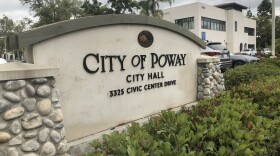The next Republican nominated for president will take the stage and wave to the crowd in ... wait for it ... Cleveland, Ohio.
That may shock you for any number of reasons, not least being that hardly anyone remembers the last time Cleveland hosted a national convention.
In fact, it was 1936, when the GOP went there to nominate a guy named Alf Landon, who carried exactly two states in November. It was the worst showing by a Republican nominee in U.S. history, which may have something to do with Cleveland's long wait for another try.
Democrats, for their part, have never held their convention in Cleveland. That may be because Ohio was so Republican for so long. From the first time the GOP even had a presidential candidate (1856) until 1964, only two Democrats carried Ohio in the Electoral College: Woodrow Wilson and Franklin D. Roosevelt — and even FDR lost the state the last time he ran.
You might also be surprised by Monday's announcement for another reason: Cleveland, famous as the bankrupt buckle on the Rust Belt in the 1970s and 1980s, has quietly made a major comeback — both as a place to visit and as a place to live. A revitalized downtown and lakefront will be on display when the TV cameras arrive in 2016.
Still, the question people ask when they hear this kind of news story is: What difference does it make? And the best answer is: Not that much.
It won't determine the nomination and it probably won't determine how Ohio votes. It isn't likely to boost the long-shot presidential hopes of Ohio GOP Gov. John Kasich.
But it matters, and it tells us something about the Republican mindset at this moment.
Until after World War II, convention locales were crucial because it could take days to get there via ground transportation. Convention cities were originally chosen to split the geographical difference between North and South (usually Baltimore) or East and West (usually Chicago).
Now, delegates and hordes of media travel by air and huddle in air-conditioned buildings. So the locale has more to do with money, politics and messaging.
The host city has to commit millions for facilities and services, but a goodly number of civic contestants queue up for the privilege every four years anyway. The value in publicity, prestige and economic benefit makes it worthwhile.
The tough call is determining which city, state and region offers the most in terms of political payoff. The first thought may be the impact in the Electoral College, but that is far from the last word. In fact, Republicans have not won the state where they nominated their ticket since they renominated the first President Bush in Houston in 1992. Since then they have held their event in California, Pennsylvania, New York, Minnesota and Florida and lost them all in the fall.
But the political signal parties send in siting the convention can be intended for a wider audience.
Ronald Reagan in 1980 went to Detroit, a majority-black and heavily Democratic city, to convert "Reagan Democrats" and launch the revolution his party still considers its mission today. The GOP held its next three conventions in Texas and Louisiana, symbolizing its focus on the Sun Belt and the oil and gas industrial complex. The party swung back to San Diego in 1996 hoping to regain some of its onetime dominance in Southern California.
George W. Bush invaded the North with conventions in Philadelphia and New York City, the first a bid for a "blue state" and the second a salute to Sept. 11 and the city's former mayor, Republican Rudolph Giuliani.
The party pursued a "purple state" strategy in 2008 and 2012, choosing Minnesota and Florida, states where the election of Republican governors augured well for better fortunes in the presidential contest. It made sense, even if it didn't work.
This time around the final choices included two cities in swing states (Denver and Cleveland) and two in Republican territory (Kansas City and Dallas). Texas in particular stands for the most conservative end of the current GOP spectrum, and another convention there would look less like outreach to traditional Southern Democrats (as in 1984) and more like circling the wagons.
Some GOP regulars had feared that another trip to Dallas would spotlight the Tea Party hard-core in Texas and the party's increasing Southern tilt (two-thirds of Mitt Romney's electoral votes came from states of the Confederacy and three culturally Southern border states).
That might be fine with many of the party's most fervent believers, but it clearly troubled most of the voters on the Republican National Committee. The RNC embodies the party establishment, and Chairman Reince Priebus is determined to raise again the Big Tent concept of Republicanism.
So now, it is back at last to Ohio, which suggests the party is reading its history and remembering how critical the Buckeye State has been to its fortunes. No Republican has ever been elected president without carrying Ohio.
The question is whether the GOP has waited too long to return, not just to Ohio but to a more mainstream definition of its electoral pitch.
Copyright 2014 NPR. To see more, visit http://www.npr.org/





